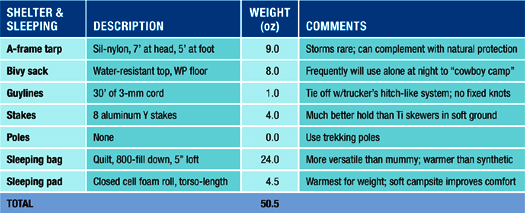

Most of my favorite backpacking destinations—notably the High Sierra, North Cascades, Wind River Range, and Colorado Rockies—are in the Mountain West. The prime season is short: The winter snowpack doesn’t melt off until June or even July, and the earliest winter storms return in October. But it’s glorious: Sunshine is abundant; humidity is minimal; and bugs are fleetingly fierce. Year-round, of course, the scenery is world-class.
I would like to thru-hike the entire Sierra High Route (SHR), a rugged 195-mile off-trail alternative to the John Muir Trail that begins in Sequoia-Kings Canyon National Park and finishes just outside of Yosemite National Park. I will start September 1 and resupply once, at Red’s Meadow at Mi 118.
The SHR stays mostly above 10,000 feet, where there is intense sunshine and scant protection from thunderstorms. Some of its 100 off-trail miles are across endless boulder fields.
Temperatures. At the bottom of Kings Canyon in September, average temperatures are 42° to 82°F. At Gem Lake, at 9,000 feet, average temperatures are 40° to 65°F, which translates to about 30° to 55°F at the route’s highest passes at 12,000-plus feet.
Precipitation. Average precipitation in September in Kings Canyon is just 0.3 inch. At Gem Lake, average precipitation is 0.7 inch.
Daylight. Including civil twilight, I will have almost 14 hours of daylight when I start.
Ground cover & vegetation. The ground cover is a mix of granite slabs, granite talus, and grassy tundra. The forested sections cross stands of whitebark and lodgepole pine. Topographical maps show a few permanent snowfields; otherwise, the route should be mostly dry by this time of year.
Sun exposure. My route is high, there is little shade, and it’ll probably be sunny for most of the trip.
Water availability. The route passes dozens of alpine lakes and small streams, so water will be relatively abundant.
Wildlife & insects. I find a Wilderness Food Storage Requirement Map on www.SierraWild.gov. About half of the SHR travels through areas where a hard-sided bear canister is required.
Remoteness. When I called Yosemite National Park to get my backcountry permit, I asked if I should expect to see anyone else during my trip. The ranger told me that backcountry traffic fades quickly after Labor Day, and that it’s possible I will not see anyone on the off-trail sections of my route.
Natural hazards. The guidebook written by Steve Roper mentions only one deep ford, across a slow-moving lake outlet. The National Park Service website says that lightning storms are common, but mostly earlier in the summer. It also says that I should purify all of my water. Avalanches are unlikely given the amount and stability of snowpack in September.




